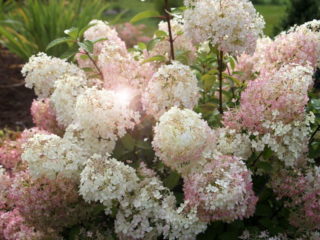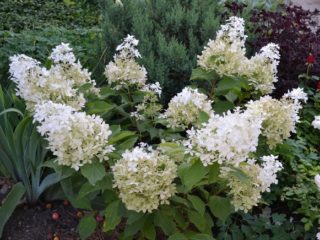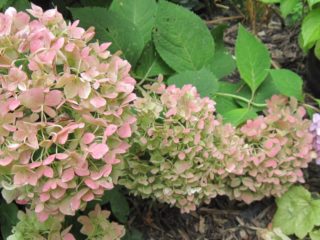Content
- 1 Is it possible to replant hydrangea in summer?
- 2 Why do you need to transplant hydrangea to another place in the summer?
- 3 When to replant hydrangea in summer
- 4 How to transplant hydrangea to a new place in the summer
- 5 How to feed hydrangea in the summer after transplanting
- 6 Care after landing
- 7 Conclusion
Hydrangea is one of the most attractive perennial plants, characterized by abundant flowering. This shrub tolerates any transplant quite painfully, but sometimes it still becomes necessary to move it to another place. The most suitable time for this is autumn and spring; as a last resort, you can replant hydrangea in the summer, but you may encounter big problems.
Is it possible to replant hydrangea in summer?
Hydrangeas are transplanted to a new location during the dormant period, in early spring, before the start of the growing season, and in the fall. The summer months, especially July and August, are a period of intense shoot growth and abundant flowering; at this time, metabolic processes occur especially quickly in the plant. Any intervention during this period can cause severe stress to the shrub; the hydrangea will simply drop its flowers, and in some cases may even die.Therefore, replanting in the summer is carried out only in case of emergency, when there is a threat of plant death (for example, a flower interferes with construction on the site).
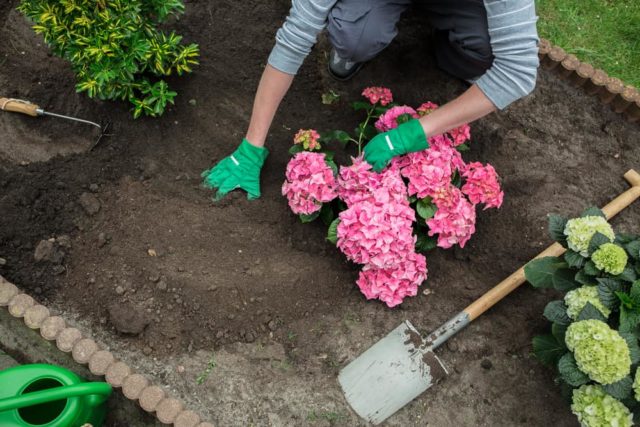
Summer transplantation is most often a necessary measure
Why do you need to transplant hydrangea to another place in the summer?
Most often, replanting in the summer may be necessary for hydrangeas in emergency cases. Unfortunately, life situations often develop in such a way that some work has to be postponed to an inopportune time. These flowers may need to be replanted in summer in the following cases:
- It is urgent to free up space in the garden (changing the layout, erecting new buildings, laying communications, storing materials, etc.).
- The plant ended up in the wrong place due to some natural reasons or weather disasters (for example, the site was flooded, the landscape changed, etc.).
- The owner is selling the garden or house and does not want to leave the flower to the new owners.
- There is a serious threat of hydrangea disease from other bushes growing in the immediate vicinity.
When to replant hydrangea in summer
Transplanting hydrangeas in any month in the summer is a very big risk. If possible, it is better to wait until the bushes have completely bloomed. Typically, the flowering of most varieties of this plant ends by the end of August, so it is better to replant at the same time.
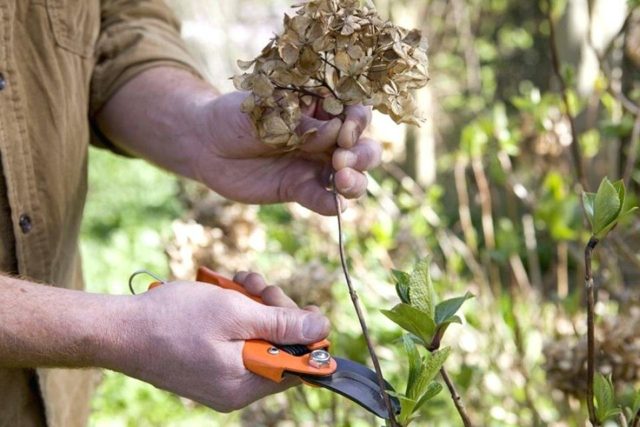
It is better to replant after flowering has ended.
In emergency cases, flowering shrubs are also replanted. However, the chances of a successful outcome of such an operation are much less.
How to transplant hydrangea to a new place in the summer
Young hydrangea bushes up to 5 years old tolerate transplantation quite well. The older the bush, the more difficult it will be for it to adapt to a new place.
Selection and preparation of a landing site
For normal growth of hydrangeas, the site for planting them must have the following characteristics:
- Illumination. Hydrangeas love plenty of light, but direct sunlight can cause them to burn. The light should be soft and diffused. These shrubs also grow well in partial shade, but in this case the number of inflorescences on them decreases. Plants growing in the shade may not bloom at all.
- The soil. The soil at the planting site should be loose, well-drained, and moderately moist. Hydrangea does not tolerate stagnant water, so it should not be planted in wetlands or where water accumulates after rain. Groundwater should approach the surface no closer than 1 m. It is important that the soil is acidic; on sandy and carbonate lands the shrub will become very sick. The optimal pH level of the soil under hydrangeas is from 4 to 5.5.
- Air temperature. Many species of these plants do not tolerate frost well, especially the most decorative, large-leaved varieties. The landing site should be protected from the cold north wind.
Preparing hydrangea for replanting in summer
Preparatory activities for transplanting hydrangeas take quite a lot of time and require considerable effort. In summer, replanting is carried out only with a lump of earth on the roots, and the larger it is, the greater the chance of a favorable outcome. It is necessary to dig planting holes in advance.Their size should be several times greater than the size of the earthen ball on the shrub that is to be replanted.
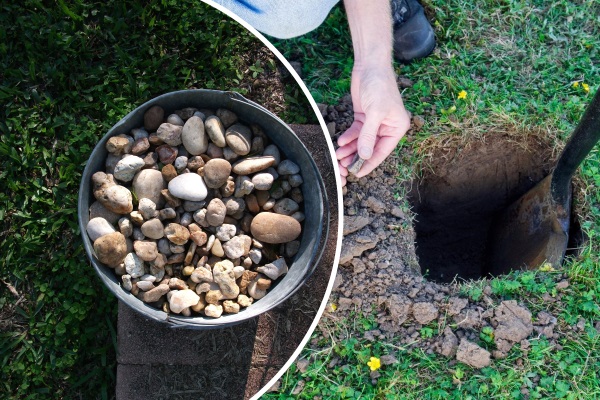
The soil should be loose and well drained
To fill the holes after replanting, a mixture of high soil and peat is prepared. A drainage layer of fragments of brick, expanded clay or crushed stone must be poured onto the bottom of the pit.
Rules for transplanting hydrangea in summer
It is important to understand that in the summer, during the replanting process, the root system of the hydrangea bush will be damaged in one way or another. This will cause a disruption in the nutrition of the above-ground part of the flower; the roots of the plant simply cannot cope with such a load. To reduce it, all flower stalks and buds need to be cut off, since the plant will still shed them after planting. The shoots also need to be cut to half their length.
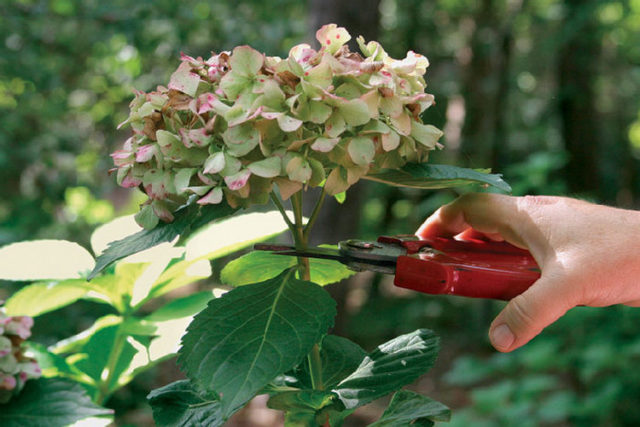
Before transplanting, cut off all inflorescences
In summer, hydrangeas are transplanted on a cloudy day. The root zone is spilled with water in advance, and then the bush is dug up from all sides approximately along the projection of the crown, trying to injure the roots as little as possible and preserve a lump of earth on them. A plant dug out of the ground is transported to the planting site on a cart or carried by hand on a piece of tarpaulin. It needs to be planted immediately. The bush is placed in the planting hole, adding a little soil if necessary so that the root collar of the plant remains flush with the soil surface.
The remaining voids are filled with soil. Having filled the planting hole completely, intensively water the hydrangea bush, and then mulch the soil surface around the bush with the bark of coniferous trees or dry pine or spruce needles. In addition to preserving moisture in the soil, mulching with such materials helps acidify the soil.
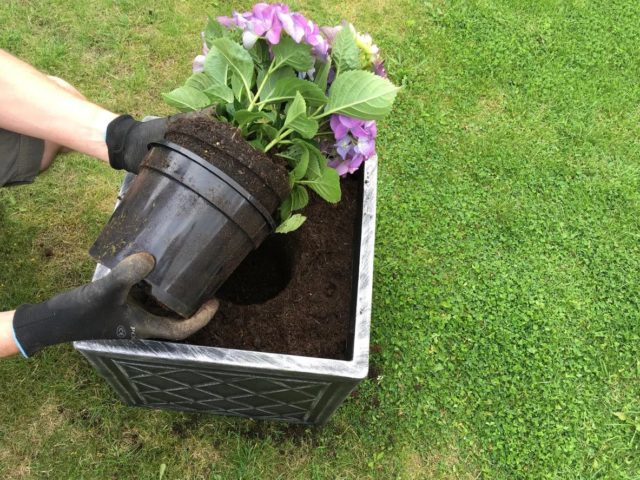
Potted species tolerate transplantation in summer much better
Hydrangeas grown as pots are less likely to run into trouble when they need to be replanted in the summer. Unlike garden plants, they tolerate this procedure much easier. However, here too it is necessary to be careful and be sure to keep the earthen lump intact on the roots. If the root system was not damaged when removed from the container, then the result will most likely be positive. Despite this, it is recommended to transship potted plants in the spring, in April.
How to feed hydrangea in the summer after transplanting
After summer transplantation, hydrangeas do not need to be fed. The growth and flowering of the shrub should not be provoked, because its root system is greatly weakened. A small amount of potassium and phosphorus mineral fertilizers can be added to the composition of the nutrient soil, which is used to fill the root system of the hydrangea bush during transplantation. However, this should only be done if the soil is initially poor. It should be remembered that the use of mineral fertilizers during transplantation can lead to burns of its roots, many of which will inevitably be damaged during transplantation. Therefore, it is better to wait for the result, make sure that the transplantation was successful, and in the fall feed the bushes with rotted manure or humus.
Care after landing
After transplantation, hydrangea bushes need rest and moderate watering. You need to navigate this issue based on the weather and, if there is insufficient amount of atmospheric moisture, periodically moisten the soil with settled rainwater.In hot weather, it is necessary to water the plants approximately once a week in the evening. You should also protect the transplanted bushes from direct sunlight, shading them with special screens made of paper or fabric.
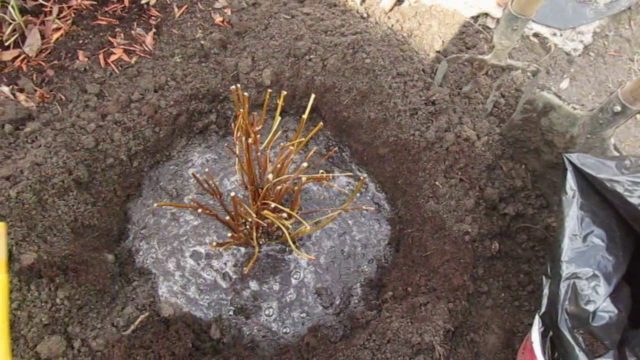
Transplanted hydrangeas need regular watering
Conclusion
It is possible to replant hydrangeas in the summer, but such a procedure can only be carried out at this time in exceptional cases. The shrub will take quite a long time to recover, but flowering should not be expected from it next season. In some cases, an unfavorable outcome is possible; the hydrangea may die. Therefore, it is so important to initially choose the right place for planting, and if you transplant to a new place, then only at the optimal time for this.



